Start with Simple and Relatable Stories
Starting with simple and relatable stories is key. Choose Bible verses that are easy for pre-schoolers to understand, like Noah’s Ark or David and Goliath. These stories are not only engaging but also teach valuable lessons. Breaking down verses into bite-sized pieces can make the content more digestible for young ones. It’s important to highlight the core message of each story to keep their attention while conveying meaningful values.
Use Props and Visual Aids
Props and visual aids can make storytelling magical. Using toys, puppets, or illustrations can bring Bible stories to life. For example, use stuffed animals to represent Noah’s Ark. Visuals help pre-schoolers visualize the story and retain the lessons.
This hands-on approach makes learning fun and interactive, capturing their imagination and interest. Make sure your props are colorful and relatable!
Incorporate Songs and Rhymes
Incorporating songs and rhymes can make Bible stories memorable. Simple tunes and catchy lyrics can help children remember key verses. Consider using classic nursery rhyme melodies with adapted lyrics to fit the Bible story. Singing together also helps in creating a joyful learning environment, making the session lively and engaging. Plus, it’s a great way to bond with your child.
Source: Image Source
Engage with Interactive Questions
Engaging with interactive questions keeps children involved. Asking questions like ‘What do you think happens next?’ encourages critical thinking and keeps them attentive. Letting them predict the story outcome can make the session more interactive and fun. This approach also helps in developing their comprehension skills while making them feel part of the story.
Create Arts and Crafts Activities
Arts and crafts activities related to Bible stories are a great follow-up. After telling the story of Jonah and the whale, you could make a whale craft. These activities reinforce the story and allow children to express their creativity. It’s a way to keep the story’s message fresh in their minds. Plus, arts and crafts are great for developing fine motor skills.
Engaging children in creative activities after biblical storytelling can enhance their learning experience and provide a hands-on approach to understanding the teachings. By incorporating arts and crafts, you create a memorable and interactive way for children to connect with the stories and values.
Build a Storytime Routine
Building a storytime routine is beneficial. Setting aside a specific time each day or week for Bible storytelling can make it a special and anticipated activity. Consistency helps in creating a habit and gives children something to look forward to. It’s a wonderful way to incorporate spirituality into their daily routine without it feeling forced.
Creating a regular storytime routine can have a positive impact on children’s development and can also be a bonding experience for the whole family. Make it engaging, interactive, and most importantly, fun!
Share Personal Stories
Sharing personal stories that relate to Bible verses can make the experience more meaningful. For instance, talk about a time you felt brave like David. Personal anecdotes make the lessons more relatable and real. It also opens up opportunities for deeper conversations with your child about values and experiences. Children love to hear about their parents’ stories, and it strengthens your bond.

